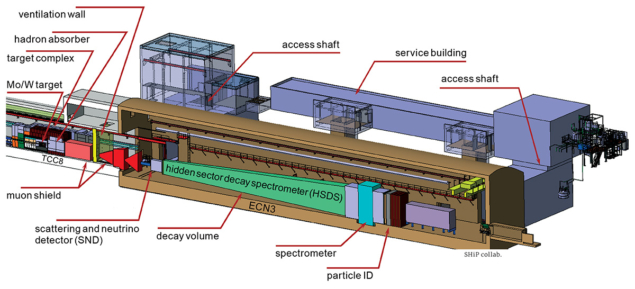
In March, CERN selected a new experiment called SHiP to search for hidden particles using high-intensity proton beams from the SPS. First proposed in 2013, SHiP is scheduled to operate in the North Area’s ECN3 hall from 2031, where it will enable searches for new physics at the “coupling frontier” complementary to those at high-energy and precision-flavour experiments.
Interest in hidden sectors has grown in recent years, given the absence of evidence for non-Standard Model particles at the LHC, yet the existence of several phenomena (such as dark matter, neutrino masses and the cosmic baryon asymmetry) that require new particles or interactions. It is possible that the reason why such particles have not been seen is not that they are too heavy but that they are light and extremely feebly interacting. With such small couplings and mixings, and thus long lifetimes, hidden particles are extremely difficult to constrain. Operating in a beam-dump configuration that will produce copious quantities of photons and charm and beauty hadrons, SHiP will generically explore hidden-sector particles in the MeV to multiple-GeV mass range.
Optimised searching
SHiP is designed to search for signatures of models with hidden-sector particles, which include heavy neutral leptons, dark photons and dark scalars, by full reconstruction and particle identification of Standard Model final states. It will also search for light–dark-matter scattering signatures via the direct detection of atomic–electron or nuclear recoils in a high-density medium, and is optimised to make measurements of tau neutrinos and of neutrino-induced charm production by all three neutrinos species.
The experiment will be built in the existing TCC8/ECN3 experimental facility in the North Area. The beam-dump setup consists of a high-density proton target located in the target bunker, followed by a hadron stopper and a muon shield. Sharing the SPS beam time with other fixed-target experiments and the LHC should allow around 6 × 1020 protons on target to be produced during 15 years of nominal operation. The detector itself consists of two parts that are designed to be sensitive to as many physics models and final states as possible. The scattering and neutrino detector will search for light dark matter and perform neutrino measurements. Further downstream is the much larger hidden-sector decay spectrometer, which is designed to reconstruct the decay vertex of a hidden-sector particle, measure its mass and provide particle identification of the decay products in an extremely low-background environment.
One of the most critical and challenging components of the facility is the proton target, which has to sustain an energy of 2.6 MJ impinging on it every 7.2 s. Another is the muon shield. To control the beam-induced background from muons, the flux in the detector acceptance must be reduced by some six orders of magnitude over the shortest possible distance, for which an active muon shield entirely based on magnetic deflection has been developed.
One of the most critical and challenging components of the facility is the proton target
The focus of the SHiP collaboration now is to produce technical design reports. “Given adequate funding, we believe that the TDR phase for BDF/SHiP will take us about three years, followed by production and construction, with the aim to commission the facility towards the end of 2030 and the detector in 2031,” says SHiP spokesperson Andrey Golutvin of Imperial College London. “This will allow up to two years of data-taking during Run 4, before the start of Long Shutdown 4, which would be the obvious opportunity to improve or consolidate, if necessary, following the experience of the first years of data taking.”
The decision to proceed with SHiP concluded a process that took more than a year, involving the Physics Beyond Colliders study group and the SPS and PS experiments committee. Two other experiments, HIKE and SHADOWS, were proposed to exploit the high-intensity beam from the SPS. Continuing the successful tradition of kaon experiments in the ECN3 hall, which currently hosts the NA62 experiment, HIKE (high-intensity kaon experiment) proposed to search for new physics in rare charged and neutral kaon decays while also allowing on-axis searches for hidden particles. For SHADOWS (search for hidden and dark objects with the SPS), which would have taken data concurrently with HIKE when the beamline is operated in beam-dump mode, the focus was low-background searches for off-axis hidden-sector particles in the MeV-GeV region.
“In terms of their science, SHiP and HIKE/SHADOWS were ranked equally by the relevant scientific committees,” explains CERN director for research and computing Joachim Mnich. “But a decision had to be made, and SHiP was a strategic choice for CERN.”







